![]()
![]()
![]()
Use LEFT and RIGHT arrow keys to navigate between flashcards;
Use UP and DOWN arrow keys to flip the card;
H to show hint;
A reads text to speech;
33 Cards in this Set
- Front
- Back
|
What are the two general phases of intestinal digestion? |
1. Luminal phase: enzymes are active in the gut lumen. Breaks down large polymers (starch, protein) via digestive enzymes from saliva, stomach, pancreas 2. Membranous phase: enzymes active at surface of gut. Breaks down small polymers (polysaccharides,peptides) via enzymes synthesized in enterocytes and attached to apical membrane.
Then monomers can be absorbed. |
|
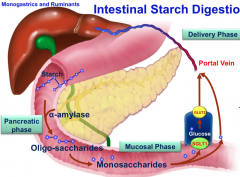
Describe intestinal starch digestion. |
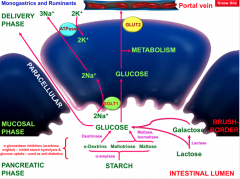
|
|
|
What transporters absorb glucose in the small intestine? What other transporter aids this process? |
1. SGLT1: sodium glucose like transporter - absorbs glucose from the lumen into the cell. (Greater expression in dogs than cats) 2. GLUT2: moves glucose from the cell into the portal circulation.
3. Na/K ATPase on the basolateral surface maintains the sodium gradient (by moving sodium out of the cell) that the SGLT1 uses to move glucose.
Note that small amounts of glucous may diffuse paracellularly. |
|
|
What do alpha-glucosidase inhibitors do? |
They inhibit starch hydrolysis by blocking enzymes and therefore prevent glucose uptake. Can be used as anti-diabetics.
IE: acarbose, miglitol |
|
|
3 Sodium Glucose Transporters |
SGLT1: kidney, intestines for glucose reabsorption SGLT2: kidney - low affinity, highly selective for glucose SGLT3: small intestine, skeletal muscle - glucose activated Na channel
Note: - high affinity but low capacity - greatest activity in jejunum - 1 glucose + 2 water for 2 Na+ - rapidly inducible by glucose |
|
|
GLUTs: The facilitative glucose transporters |
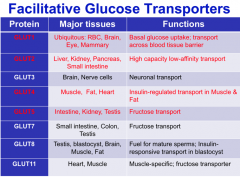
- GLUT1 ubiquitous - GLUT4 insulin dependent - GLUT5 insignificant in ruminants
|
|
|
How does the ruminant's efficiency of digestion compare in its different parts of GI? |
SI (97%) > LI (80%) > rumen (60%) |
|
|
Ruminal Digesta Phases/Fractions |
- Gaseous phase - Fibrous raft (most microbes) - Liquid fraction (moves saliva and fermentation end products in/out)
- Boundary layer against lumen surface (bidirectional fluid exchange) - Soupy material in ventral and cranial sacs (cud and material or omasum) |
|
|
6 Fermentation Requirements |
1. Substrate (regular supply of feed) 2. Microbes (rate of removal must equal regeneration) 3. Mixing and propulsion 4. Fermentation end products must be steadily removed (VFAs, gases, solid waste etc) 5. Stable intraruminal conditions (37C temp, 300mOsm, pH 6.4, anaerobic conditions, negative oxidation reduction potential) |
|
|
What is the role of rumen protozoa? |
Digestion and fermentation: - engulf feed particles, digest/store CHO, proteins and fat - ingest bacteria - produce some VFAs and ammonia - slow digestion of rapidly fermentable starches and proteins - note that they will decrease with high grain diets and pH less than 5.5
|
|
|
What are advantages of rumen protozoa? |
Advantages: - Store starch particles to prevent rapid degradation by amylolytic bacteria - Provide a reservour of microbial protein during scarcity - Provide protein, starch and PUFAs when digested by host |
|
|
What are the types of rumen bacteria? |
Based on location: - Freeliving in the liquid - Associated with feed particles - Associated with rumen epithelium - Attached to surface of protozoa and fungi
Based on fermentation: 1. Primary bacteria (18h cellulytic or 4h amylolytic pH5.5-6.6) 2. Secondary bacteria (proprionate bacteria use lactate, methanogenic bacteria use H2/formate) 16h to double, pH 6.2-6.8 |
|
|
What happens to cellulose digestion if unsaturated fat is fed? Why? |
Digestion of cellulose decreases because the fat interferes with bacterial attachment to plants. |
|
|
Describe the process which bacteria attaches to plants. |
1. Free bacteria move to fibrous substrate. 2. Initial nonspecific adhesion (electrostatic/ionic) on cut surfaces. 3. Specific adhesion (ligands/adhesins) on bacterial surface. 4. Proliferation and colonization on feed. |
|
|
What are 5 benefits of bacterial attachment to plants? |
1. Brings enzymes and substrates close together. 2. Protects enzymes from rumen proteases. 3. Allows bacteria to colonize the digestible surface of feed particles. 4. Retention in the rumen to prolong digestion. 5. Reduces predatory activity of protozoa |
|
|
Compare the function, storage abilities, location, number, size and pH sensitivity of rumen protozoa and microbes. |

|
|
|
In the various species, where are VFAs produced? How do they contribute to the total energy requirements? |
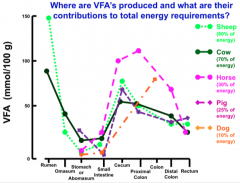
|
|
|
How are VFAs made in the rumen? |
![- Starch, cellulose, glucose, fructose, hemicellulose, pectin are converted into fructose 1,6 BisP and then to phospohenolpyruvate [hydrolysis + glycolysis]
- Phosphoenolpyruvate is turned into acetate, formate or pyruvate
- Formate will become me...](https://images.cram.com/images/upload-flashcards/83/98/23/8839823_m.png)
- Starch, cellulose, glucose, fructose, hemicellulose, pectin are converted into fructose 1,6 BisP and then to phospohenolpyruvate [hydrolysis + glycolysis] - Phosphoenolpyruvate is turned into acetate, formate or pyruvate - Formate will become methane and CO2 - Pyruvate can become butyrate (via AcetylcoA) or propionate (via lactate or oxaloacetate) - Acetate can be turned into butyrate
4 Stages: 1. Hydrolysis 2. Glycolysis 3. VFA synthesis 4. Microbial protein synthesis
|
|
|
What are the 2 pathways for propionate synthesis from pyruvate? |
Direct reductive pathway (10-30%): Lactate becomes acrylate then via propionate bacteria, then becomes propionate.
Randomizing pathway (70-90%): Oxaloacetate becomes succinate via randomizing pathway, then becomes proprionate. |
|
|
How does diet composition affect VFA production? |
- Forages favour acetate - Concetrates favour proprionate - Butyric remains the same (always lowest) - Total VFA production increases with more concentrates |
|
|
How does milk production and milk fat vary with diet composition? |
Concentrates will increase milk production but decrease % of fat in milk
|
|
|
How are VFAs absorbed? |

Apical side/Entry into cell: - Lipiphilic undissociated short chain fatty acids (HSCFA) can diffuse into the cell, where they release their protons (now SCFA). - SCFA transporters exchange anions (less lipophilic SCFAs) with bicarbonate. - Lactate is cotransported with its proton.
Basolateral side/exit to blood: - Butyrate metabolized to ketones (BHBA, acetoacetate) and propionate metabolized to lactate is expelled via monocarboxylate transporter 1 (MCT1) - Cl/SCFA antiporter - Bicarbonate/SCFA anitporter - Note the mechanisms for neutralizing/removing the H+ that has been brought into the cell - Not shown: bicarbonate inside cell is also replenished via carbonic anhydrase reaction.
- - |
|
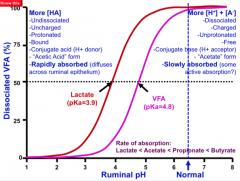
What is the significance of this? |
- Rate of absorption: lactate>acetate>propionate>butyrate
Find out more! |
|
|
What is the fate of VFAs after absorption? |
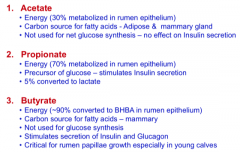
Acetate: lipids, energy Proprionate: Lactate, glucose, energy Butyrate: FA synthesis (in mammary), energy
|
|
|
What does grain do to the rumen? |
- Decreases pH (pH on forage = 6.6-6.8) - Stratum corneum sloughing, then excessive keratinization of the epithelium (parakeratosis) |
|
|
What is the mechanism of rumen acidosis due to increased fermentable CHO in the diet? |
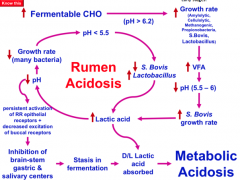
|
|
|
When does the bacteria S. bovis thrive? What about Lactobacilli? |
S. bovis: When there is a increase in availability of fermentable CHO, especially if the animal is unadapted to it. Lactobacilli: in low pHs (pH 5.6) |
|
|
Basics of ATP synthesis |

|
|
|
What is the rate limiting enzyme in glycogenesis in the liver and muscle? |
Glycogen synthase |
|
|
What are the rate limiting enzymes in glycogenolysis in the liver and muscle? |
Glycogen phosphorylase (first step in glycogen breakdown) Glucose-6-phosphatase (last step before become glucose - contributes to blood glucose) * Not in muscle! Glucose-6-phosphate is used for ATP instead of blood glucose. |
|
|
What is the Cori cycle? |
Lactate from muscle is transported to the liver via blood, where it is used for gluconeogenesis. (And therefore eventually returned to the muscle as glucose via the blood.) |
|
|
4 types of hypoglycemia |
1. Insufficient gluconeogenesis and glycogen stores (ie ruminants during lactation, neonatal pigs, adrenal cortex/pituitary deficiency, liver disease) 2. Mesenchymal tumours (inhibition of glucagon) 3. Glycogen storage diseases 4. Hyperinsulinemia (Tumor of Islets, hypersecretion of insulin after fasting and carb eating, Somogyi overswing - insulin overdose and overcompensation) |
|
|
Types of Diabetes Mellitus |
1. Type 1 (Juvenile/IDDM): primary insulin deficiency due to beta cell failure (autoimmune disorder). Common in dogs and cats. 2. Type 2 (Adult onset/NIDDM): primary insulin resistance due to beta cell exhaustion/atrophy. Less common in animals, can be seen transient in cats and early lactation cows. 3. Other: gestational, diestrus |

